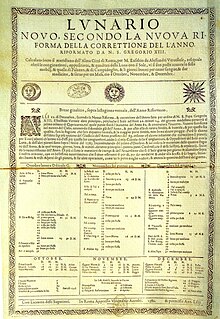 Global Information
Global InformationAdoption of the Gregorian calendar information

The adoption of the Gregorian Calendar was an event in the early modern history of most cultures and societies, marking a change from their traditional (or "old style") dating system to the modern (or "new style") dating system – the Gregorian calendar – that is widely used around the world today. Some states adopted the new calendar from 1582, some did not do so before the early twentieth century, and others did so at various dates between. A few still have not, but except for these, the Gregorian calendar is now the world's civil calendar universally, although in many places an old style calendar remains used in religious or traditional contexts.[1][2][a] During – and for some time after – the change between systems, it has been common to use the terms "Old Style" and "New Style" when giving dates, to indicate which calendar was used to reckon them.
The Gregorian calendar was decreed in 1582 by the papal bull Inter gravissimas by Pope Gregory XIII, to correct an error in the Julian calendar that was causing erroneous calculation of the date of Easter. The Julian calendar had been based upon a year lasting 365.25 days, but this was slightly too long; in reality, it is about 365.2422 days,[b] and so over the centuries, the calendar had drifted increasingly out of alignment with the Earth's orbit. According to Gregory's scientific advisers, the calendar had acquired ten excess leap days since the First Council of Nicaea (which established the rule for dating Easter in AD 325). Consequently, he ruled, ten days must be skipped to restore the status quo ante: Catholic countries did this in 1582. Countries which did not change until the 18th century had by then observed an additional leap year (1700), necessitating the dropping of eleven days. Some countries did not change until the 19th or 20th century, necessitating one or two further days to be omitted from the calendar.
Although Gregory's reform was enacted in the most solemn of forms available to the Church, the bull had no authority beyond the Catholic Church and the Papal States. The changes he was proposing were changes to the civil calendar, over which he had no formal authority. They required adoption by the civil authorities in each country to have legal effect. The bull became the canon law of the Catholic Church in 1582, but it was not recognised by Protestant churches, Eastern Orthodox Churches, and a few others. Consequently, the days on which Easter (and related events in the Liturgical calendar) were celebrated by different Christian churches diverged.
- ^ Introduction to Calendars Archived 13 June 2019 at the Wayback Machine. United States Naval Observatory. Retrieved 15 January 2009.
- ^ Calendars Archived 1 April 2004 at the Wayback Machine by L. E. Doggett. Section 2.
Cite error: There are <ref group=lower-alpha> tags or {{efn}} templates on this page, but the references will not show without a {{reflist|group=lower-alpha}} template or {{notelist}} template (see the help page).